2016
66th Berlin International Film Festival
February 11 – 21, 2016
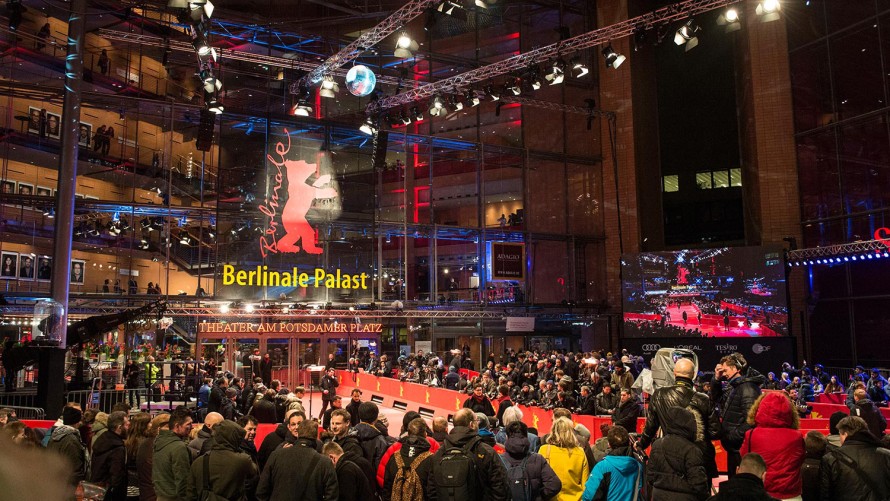
66th Berlinale: the highlights
“The predominant topic: politics, art and the subtle, tense links between the two in a time when it no longer seems possible not to take a position, to keep out of things and simply look away whilst the world is confronted with momentous decisions and developments.” – Thomas Schultze, Blickpunkt Film, February 29, 2016
2016: the world in motion. “We can do it!” the Chancellor dictated into the history books on August 31, 2015. She was referring to the millions of refugees making their way to Europe from Africa and the Middle East. During the following weeks, the German culture of welcome was unparalleled: images of people in Munich applauding refugees arriving at the main railway station went around the world. But gradually disenchantment set in. Refugee hostels went up in flames. Three weeks after the Berlinale ended, the right-wing Alternative für Deutschland (Alternative for Germany) party scored record-breaking results in three state elections and Europe erected barbed-wire fences along its external borders in the name of “security”. A muddy tent city sheltering thousands of refugees grew around the Greek village of Idomeni after Macedonia opted to seal itself off. People died in the attempt to cross the river on the border between Greece and Macedonia. In this regard, the 66th Berlinale was a very special festival. As Rachel Donadio put it on February 21, 2016 in the New York Times: “Perhaps more gripping than any drama onscreen is the one playing out in Germany itself, where the arrival of more than one million asylum-seekers in the past year — 80,000 of them in Berlin — has been challenging the country’s ideas about itself. ”
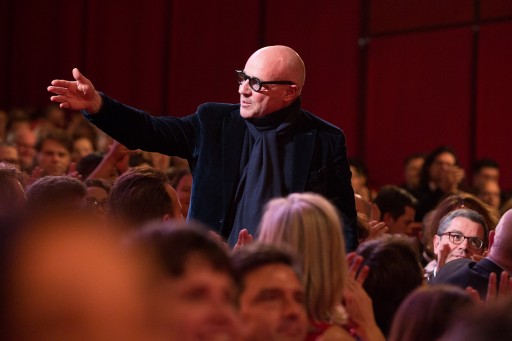
Gianfranco Rosi at the Award Ceremony in the Berlinale Palast
It is before this particular backdrop that the full power of the International Jury’s decision about the winner of the 2016 Golden Bear becomes apparent: the award went to Fuocoammare, a documentary-style film by Italian director Gianfranco Rosi. It tells the story of Lampedusa, a small Mediterranean island which, for years, has been a focal point of all the wretchedness of being a refugee: a place which at once symbolises the past, the present and the future of the new world order. The personified memory of this despair, the doctor Pietro Bartolo who has followed the movement of refugees since 1991 and has had to tally the number of deaths and raped women on a daily basis, provided for one of the most emotional press conferences of the festival. To see in order to tell: at stake above all else was the visibility of this new world. In the words of Festival Director Dieter Kosslick: “We are seeing the migration of 60 million to 70 million people around the world in front of our eyes. A worldwide catastrophe is happening and we can’t say, as the Germans said in 1945, we didn’t see it, we had no idea” (in an interview with Leo Barraclough in Variety, February 19, 2016).
In this regard, the timing of the 66th Berlinale was a stroke of luck, since the filmmakers had already begun working on their films months or even years before. Hence Gerhard Midding’s accusation that the Competition was “dominated by the current topics of do-gooders’ cinema” (Der Freitag, February 25, 2016) was unfounded. “Rosi’s brilliant images, which neither lose their clarity at night nor under water, [...] make it clear that this film is compelling not only in its subject matter but also aesthetically. The footage of a group of refugees silhouetted against the light whilst their bodies are wrapped in rustling golden survival foil, is unforgettable” (Hannah Pilarczyk, Spiegel Online, February 13, 2016).
Realities
In 2016 the filmmakers interrogated their own capabilities and the implications of their medium. Whilst reviews resorted with striking frequency to the word “reality” to characterise the 66th edition (“reality wins”, “triumph of reality”), it became increasingly apparent that the concept of a monolithic REALITY as such was obsolete. This was visible in films including Fuocoammare in which lives run parallel to each other with hardly any points of intersection. There are the islanders and there are the refugees – and they have very little in common.
In this way, cinema in 2016 proved its absolute necessity, its inexhaustible potential as a space for awareness, memory and reflection. In the individual works, the topic of flight emerged on an aesthetically very high level. A paradigm of this was Havarie in the Forum. Starting from a three-minute video he discovered on YouTube, director Philipp Scheffner undertook extensive research to understand the story behind this clip which depicts a stricken refugee boat in the Mediterranean filmed from the perspective of a cruise liner. When the filmmaker returned to Germany, the media overkill in reporting on the refugee crisis had reached its first peak and Scheffner realised it would be impossible to complete Havarie in the form he had intended. The deluge of images had led to apathy and impotence (“during the work on this film, images overtook reality”, as the film’s synopsis puts it). And so Scheffner expanded the three-minute clip into 90-minute cinema and the statements of the interviewees were now to be heard as voiceover.
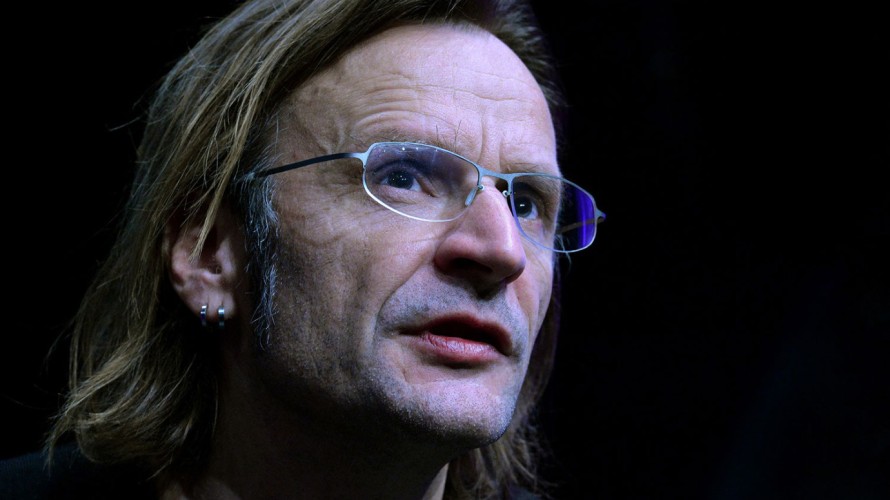
Philipp Scheffner on Havarie
The films did not condemn. Instead, each approached the subject matter in its own way. Head of Forum Expanded Stefanie Schulte Strathaus said of her section that there were no films which did not in some way deal with the refugee crisis but the works provided a necessary broadening of context. For example, Now: End of Season by Ayman Nahle which combines images of stranded refugees in Istanbul with a historical phone call between Hafiz al-Assad and Ronald Reagan. In the end, the conversation does not actually take place, Reagan fails to come to the phone and al-Assad is left hanging on the line. The conflicts in which the West, under pressure from refugee movements, is now interested, were seeded in the past – and film is needed to make these connecting lines visible. Because the images in daily news reports simply switch from one crisis (capitalism/the Euro) to the next (refugees) without even mentioning that one perhaps has something to do with the other. Dieter Kosslick made this clear in a conversation with Dirk-Oliver Heckmann (Deutschlandfunk February 10, 2016): “This is the first brutal response to uncontrolled economic globalisation. This is what we have now and it will continue.”
Havarie and Now: End of Season were just two films in a whole range of works which utilised a rigorous uncoupling of sound and image. And in his second work in the Forum, And-Ek Ghes... , Scheffner presented another cinematic device which proved influential at the 66th Berlinale: he installed his protagonist Colorado Vecu as co-director. From this point onwards, Vecu acted in the double function of director/protagonist and told and staged parts of the story of his arrival in Germany himself. The same technique was deployed by Estephan Wagner and Moritz Siebert in the production of their Danish film Les Sauteurs: whilst filming around the Spanish enclave of Melilla, they employed Abou Bakar Sidibé from Mali as their third director. The view of the border fence, the hope that is Europe, was thus fundamentally changed and the voices of the marginalised and excluded were raised: the refugees were less talked about and their perspective was taken more into account. Life on the Border in Generation seamlessly took up the thread: Kurdish filmmaker Bahman Ghobadi gave children in the Kobanê and Singal refugee camps cameras to enable the audience to see everyday life through the children’s own eyes. The Berlinale itself reacted to the tense situation and the need for integration with calls for donations, sponsored cinema visits and a series of work experience placements for refugees in the different areas of the festival.
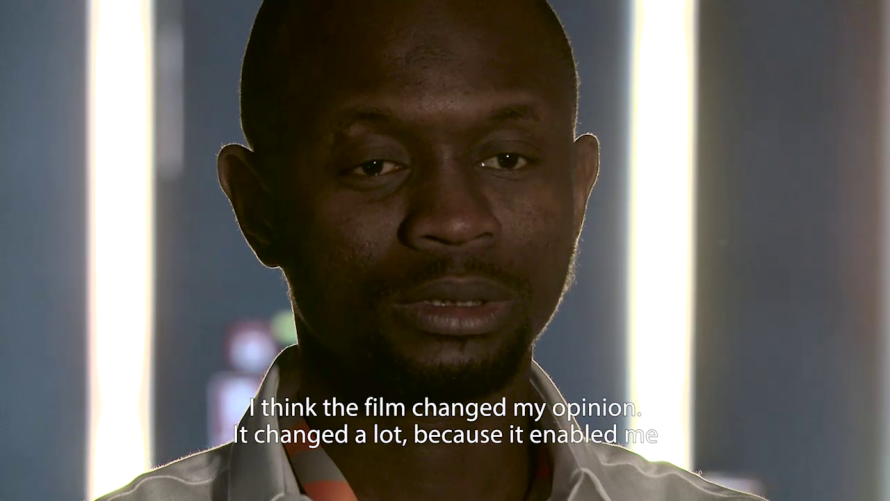
E. Wagner, A. B. Sidibé and M. Siebert on Les Sauteurs
Attitude Is Everything
The attitude of the filmmakers towards their subjects was a deciding factor; it became clearer than ever that merely filming the world might produce pictures but these are far from constituting a film. “The attitude is the foundation, and we encourage that in the Talents,” Berlinale Talents Project Manager Christine Tröstrum stated for the record; and Berlinale Shorts Curator Maike Mia Höhne responded to a question regarding the qualities required of a film in her section by saying: “It must have a very strong individual style of the artist and a very strong attitude” (Szene Hamburg, February 12, 2016). This is a type of filmmaking which also has a long tradition in Germany, as evidenced in the 2016 Retrospective “Germany 1966 – Redefining Cinema”, one which addressed the anniversary of a decisive turning point in film history: as young filmmakers in the East and West in the 1960s began to interrogate the socio-political reality on both sides of the Wall, and directors in the West achieved success under the “New German Cinema” label, the 11th plenum of the Socialist Unity Party in East Germany decided to ban half of the feature films made in that country. In an interview conducted by Christiane Peitz with Volker Schlöndorff (West) and Wolfgang Kohlhaase (East), Kohlhaase explained: “Cinema was generally politicised. Not as an exaggerated pose but as an attitude. It was to refer to the world. That was something on which all of us at DEFA agreed” (Der Tagesspiegel, February 13, 2016).
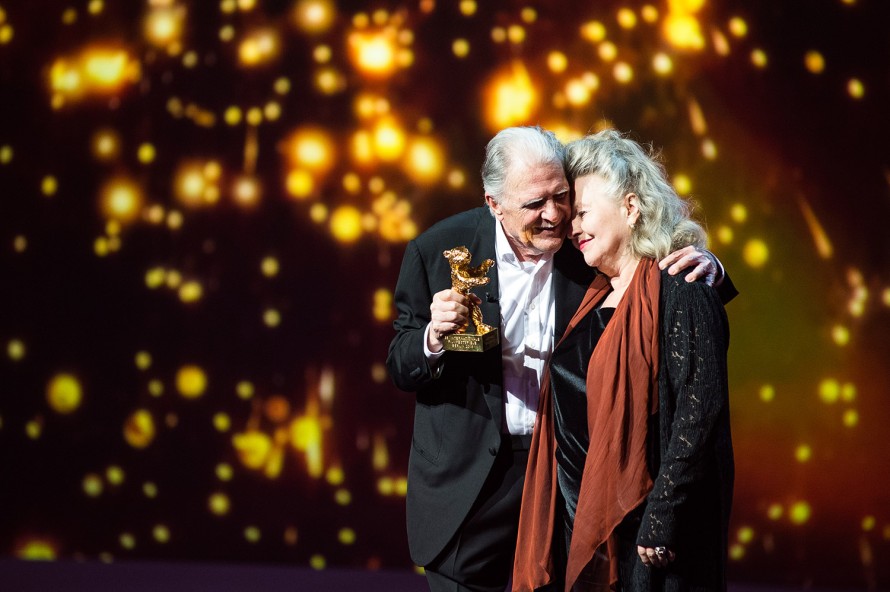
Michael Ballhaus and Hanna Schygulla at the Award Ceremony
Someone who began his career in the 1960s as cinematographer for the New German Cinema wunderkind Rainer Werner Fassbinder, provided another emotional highlight of the festival: as guest of the Homage, Michael Ballhaus was awarded the Honorary Golden Bear on February 18, 2016. The Berlin-born 80-year old was received with tremendous warmth. He has collaborated with the most eminent international directors for decades and yet has remained down-to-earth and modest: “Before he realised his dreams and became a cinematographer, he undertook a two-year apprenticeship in a Würzburg photo studio. This taught him humility and a motto which he adopted as his own: ‘My profession is a serving one’” (Der Tagesspiegel, February 17, 2016).
Glamour and Participation
In this respect, Ballhaus was emblematic of how the various demands in 2016 had to be dealt with. The balancing act between glamour and star cinema on the one hand and pressing political and humanitarian challenges on the other was more difficult than ever before. The festival opened with Hail, Caesar!, a nostalgic homage to old Hollywood cinema by Joel and Ethan Coen. An overwhelming festival atmosphere on the first night, star power. Yet, on the festival’s first red carpet, Festival Director Dieter Kosslick gave an emphatic reminder not to forget those who did not have the opportunity to take part. That Hollywood glamour can have a powerfully political effect was demonstrated the next day as George Clooney – part of Hail, Caesar!’s star cast – together with his wife, human rights lawyer Amal Ramzi Alamuddin Clooney, spoke with Angela Merkel in the chancellery about the refugee situation.
Flight, forced exile, questions about co-existence, the possibility of integration – all issues which flared up with a new intensity in February 2016 and which the Berlinale has long since focused on. This became clear at a remarkable birthday party: the Teddy, the only official queer film award at an A-list festival, turned a full 30 years old “and whilst in 1987 ‘there were 15 people hanging around in a bookshop and watching films on 16 mm,’ as Teddy-creator and Panorama curator Wieland Speck recalled, today the gala is being broadcast by Arte as a livestream” (Maike Schultz, Berliner Zeitung, February 22, 2016). The film series accompanying the anniversary gave added cause to look back at the section’s own programmatic history as well as at queer history in general and to see how much the politics of cinema have contributed to emancipation and acceptance. And Speck explicitly did not want integration to be understood as a process of subjugation: integration is only possible if both sides encounter each other with mutual respect and on an equal footing.
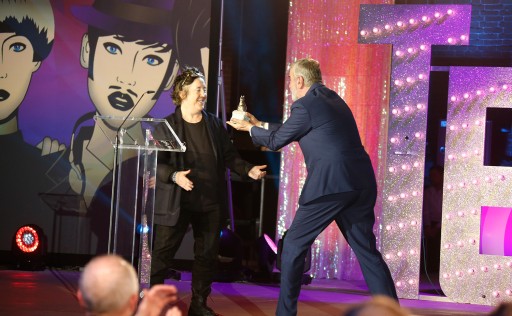
Wieland Speck giving the Special Teddy 2016 to Christine Vachon
In the official Panorama programme, the general uncertainty in the face of the world’s “crises” manifested itself in a myriad of sudden events: killing sprees, accidents, self-induced catastrophes and a longing for the return to a homeland. The latter in particular also played an important role in the other sections. For the 2016 edition of Generation, section head Maryanne Redpath stated that the films frequently created fantastic dream worlds and in many cases these surreal universes were safe havens. This was expressed even more clearly by Maike Mia Höhne who understood the Berlinale Shorts programme to be one large cinematic essay driven by the yearning to arrive.
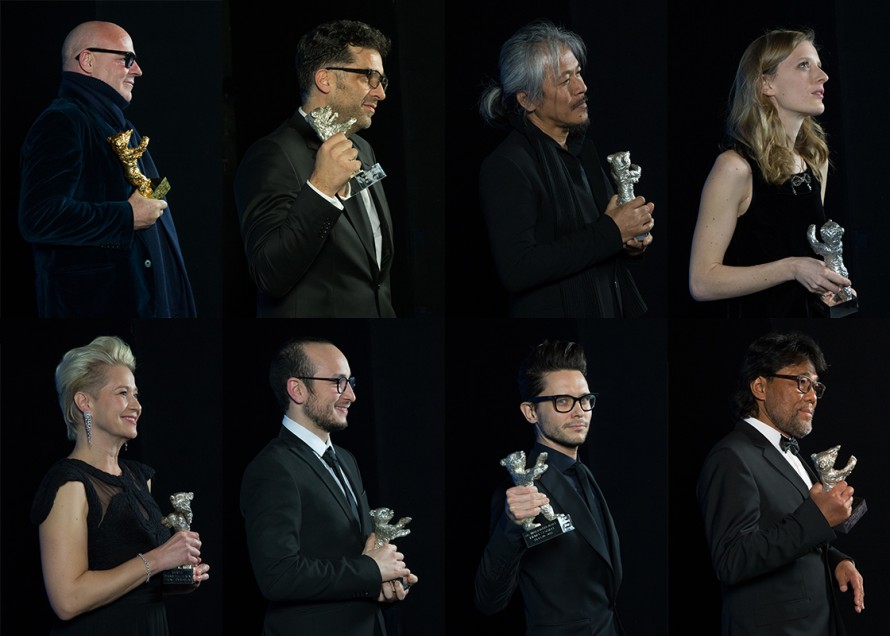
The winners of the 2016 Competition: Gianfranco Rosi, Danis Tanović, Lav Diaz, Mia Hansen-Løve, Trine Dyrholm, Majd Mastoura, Tomasz Wasilewski and Mark Lee Ping-Bing
The Competition Prizes
The Competition could not satisfy the critics with its range as it did last year because some of the films fell short in the eyes of some journalists. However, the overall balance was positive: “The festival must nevertheless be counted as a success: Kosslick has once again managed to draw large media attention to world cinema outside of the Anglo-American mainstream.” (Andreas Borcholte, Spiegel Online, February 21, 2016). And so the Silver Bear Grand Jury Prize went to Bosnian-Herzegovinian filmmaker Danis Tanović (for Smrt u Sarajevu / Death in Sarajevo), the Alfred Bauer Prize to Filipino director Lav Diaz who, with his 485-minute epic Hele Sa Hiwagang Hapis (A Lullaby to the Sorrowful Mystery) provided the first 9 am red carpet at the Berlinale and nevertheless excited the audience: “After this film you didn't leave the cinema exhausted but instead inspired, even euphoric. Lav Diaz shows how images can tear down the fortifications of purportedly standardised stories by means of their own meandering, questioning, open narrative” (Katja Nicodemus, Zeit-Online, February 25, 2016). Mark Lee Ping-Bing was honoured for his cinematography in the Chinese entry Chang Jiang Tu (Crosscurrent) by Yang Chao. Majd Mastoura won Best Actor for his performance in Inhebbek Hedi (Hedi) by Mohamed Ben Attia (who also took home the Best First Feature Award). The Tunisian actor dedicated his prize to the victims of the revolution in his homeland and, in doing so, drew attention to a country which in the overkill of the daily political news cycle has already disappeared again off the media’s world map. The rest of the Bears remained in the increasingly shaky political construct that is Europe: Mia Hansen-Løve was honoured as Best Director for L’avenir (Things to Come), Trine Dyrholm as Best Actress for Kollektivet (The Commune) by Thomas Vinterberg and the Silver Bear for Best Script went to Poland, to Tomasz Wasilewski for Zjednoczone stany miłości (United States of Love). The single German Competition entry came away empty-handed in terms of awards but was extensively praised by the critics. On February 20, 2016, James Woodall wrote in The Spectator about Anne Zohra Berrached’s 24 Wochen (24 Weeks): “It grips like nothing else I’ve seen in German cinema in the past decade.”
And so the Berlinale was, in spite of the critical voices, able to continue its success story in 2016. As in the previous years, ticket sales increased, the European Film Market posted record figures and the festival’s profile was further sharpened: “It seems that nowhere is there more discussion about images than here. Whoever talks about film comes to an understanding about their own perspective and that of others, about pain, longing, narrative styles and social morality. About the world we live in and the world we want to live in” (Christiane Peitz, Der Tagesspiegel, February 21, 2016).
| Visitors | |
|---|---|
| Total amount of theater visits | 503,900 |
| Tickets sold | 335,986 |
| Professionals | |
| Accredited guests (press excl.) | 16,770 |
| Countries of origin | 122 |
| Press | |
| Journalists | 3,804 |
| Countries of origin | 86 |
| Screenings | |
| Number of films in the public programme | 395 |
| Total amount of screenings | 1,060 |
| European Film Market | |
| Film industry participants | 9,230 |
| Number of films | 784 |
| Number of screenings | 1,124 |
| EFM-Stands (Martin-Gropius-Bau & Business Offices) |
182 |
| Number of exhibitors | 543 |
| Berlinale Co-Production Market | |
| Participants | 583 |
| Countries of origin | 52 |
| Berlinale Talents | |
| Participants | 300 |
| Countries of origin | 79 |
| Annual budget | € 23 million |
| The Berlin International Film Festival receives € 6.7 million in institutional funding from the Federal Government Commissioner for Culture and the Media. |